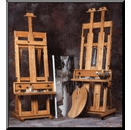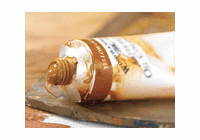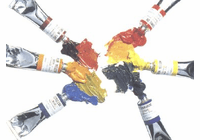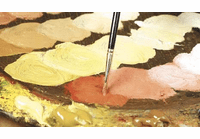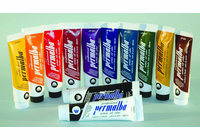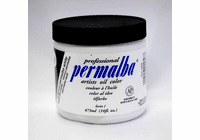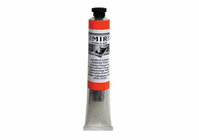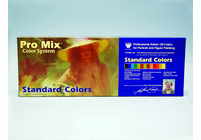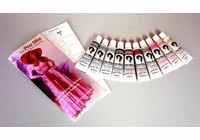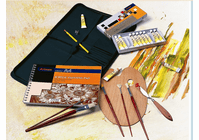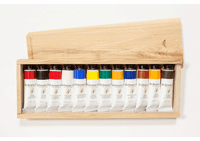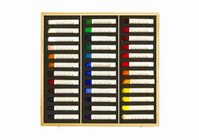OIL PAINTS
Oil Paint Supplies
Blockx oils / Holbein Oils / Winsor & Newton Artists' / Winton / Artisan / Daniel Greene Oils / Alvin Oils / About Oil Paints & Tips On Oils and more
Oils - Professional Grade & Student Grade Oil Paints
Blockx oils / Holbein Oils / Winsor & Newton Artists' / Winton / Artisan / Daniel Greene Oils / Alvin Oils / About Oil Paints & Tips On Oils and more
Oils - Professional Grade & Student Grade Oil Paints
Oil Painting Supplies: Oil Paints
All of our paints conform fully to all U.S. Federal Safety Standards for art supplies.
It is best to start with a palette of three or four colours, then add one or two more as you gain experience. Adding white to a colour produces a tint. Adding black produces a shade.
We have listed above the selected colours we prefer, but even just three colours, plus white, will produce a wide range of tints.
When you look at a landscape you can see at once that although most of the elements in it may be green, they are not likely to be the same green. Mix a range of natural greens from the other paints.
Here is a link to a friend's web-site "elementary notions about oil painting by Leon Engelen" with more tips and techniques:www.engelen.com/selno/notions.htm
A little more on color theory & mixing oil colors:
But for large-scale works or long-term use of specific colors, it is advisable to create a larger quantity of color. Mailing labels are great for labeling your tubes. One tip is to roll the bottom of the tube tightly and do not trap air between the bottom of the tube and the store of paint.
Experimentation with the oils you might already have will get you started and give you a chance to explore many possibilities as well as be creative.
Go outside, look up and paint!
Enjoy your painting!
***
--------------------------------------------------------------------------------
3 TIPS FOR PAINTING LIKE THE IMPRESSIONISTS
By Greg Albert
The Artist's Magazine and Artist's Sketchbook
As most of us know, one of the most popular and widely imitated art movements in the history of Western art is Impressionism. It's an approach to painting originated by a group of French painters, and although each member had a unique style, they all shared many things in common that gave their paintings a distinct look.
Paint outdoors on location. The Impressionists painted directly from nature; so should you. They attempted to look at the landscape as objectively as possible, recording how natural light illuminates the clouds, trees, grass and buildings around them. There's no substitute for painting what you really see outside.
Don't overdo hard edges. The Impressionists weren't "paint by number" painters. That is, they didn't outline a shape with line then "color it in," like in a coloring book. Instead, they built up shapes with strokes and touches of color that softened the edges in their paintings.
Suggest detail; don't describe it. Look at your subject matter comprehensively; don't fixate on individual details. Try squinting to obscure sharp detail. Trying to see and paint every detail will distract you from the overall impression you're trying to create.
***
MORE TIPS ON OIL PAINTS
Direct vs. Indirect Oil Painting
What are direct and indirect oil painting?
Paint is applied to a surface either directly or indirectly. Direct painting involves applying one layer of paint to a surface. Indirect painting involves painting a surface with many different layers of paint to create rich tones and numerous effects.
Oil Paint Colors
What are oil paint colors?
Oil paint colors are unmatched for purity, quality, and permanence. Oil paints are considered to be the highest quality paint type for mixing colors for shading. Oil paint colors date back to the 16th century when it was used to decorate wooden shields.
Painting 'Fat' Over 'Lean'
What does painting 'Fat' over 'Lean' mean?
Have you heard the term painting fat over lean? This term refers to a basic rule of painting with oils. Oil that is used directly from the tube is thick and is the “fat.” “Lean” paint is oil paint that has been thinned. When painting in layers you should always apply the thin paints first.
If you apply the thick paints first this can cause your paint to crack. When working in layers each new layer of paint should be thicker than the underlying layer of paint.
Preserving leftover Oil Paints
How do you preserve leftover oil paints?
The moment your paint hits the air it starts to dry out. Preserving leftover paint does not have to be an issue. Simply cover the entire palette in plastic wrap and store it in the freezer.
Student vs. Professional Oil Paints
What are the different grades of oil paints?
Oil paints come in student and professional grades. Student grade oil paint carries a lower concentration of pigment. It also has a smaller range of color options to choose from versus professional grade oil paint. However, the less expensive student grade paint is a great alternative for students and beginning artists. Using student grade oil paint gives the option of experimenting without feeling like you are wasting your money while learning.
The Health Hazards of Oil Painting
How can I avoid the health hazards of oil painting?
Being an artist who oil paints can pose a risk to your health. Pigments that contain metals such as lead or chromium can easily be absorbed through your skin. Solvents like turpentine and varnish are also harsh on the skin. These solvents also produce fumes that should not be inhaled for long periods of time. Experiment with newer and safer products such as turpenoid. You can also try using linseed for thinning your paints. You should always paint in a well ventilated area.
The Ingredients of Oil Paints
What are oil paints made of?
Oil paints are made of natural pigments that are suspended in oil that acts as a binder. The most common oil found in oil paint is linseed oil, although walnut oil, sunflower oil and poppy oil can also be used. Many manufacturers also add other ingredients such as stabilizers for texture and dryers to aid the drying process.
The Vocabulary of Oil Painting
What are the popular terms of oil painting?
Oil painting has its own language. Most of the terms have their origins in Italian. For instance, impasto, means a thick application of paint. Alla prima means ‘all at once' or completing a painting in one sitting. Chiaroscuro literally means ‘light dark' and describes the contrast of light to dark to create a dramatic effect.
Varnishing Your Oil Painting
When do you varnish an oil painting?
Were you aware that your finished oil paintings should have a coating of varnished applied to it? Did you also know that it could be six months or longer before your oil painting is fully dry? Your painting should be stored in a dust free area while it is drying. Be careful when you apply varnish and make sure it is the correct gloss. Dammar Varnish is a high gloss while ConservArt Varnish has a lower glossy finish. Matt Varnish will produce a matt finish.
Varnishing Your Oil Painting
How do you varnish an oil painting?
When you are applying varnish to your dried oil painting use a flat brush. Lay the painting on a flat surface and use long strokes and work from top to bottom. You should always apply the varnish in the same direction. It takes about a day for a coat of varnish to dry. Once it has dried, apply the second coat of varnish at right angles to the first application.
Paper is popular for sketching in oil and also liked by professionals for its texture and drag.
All of our paints conform fully to all U.S. Federal Safety Standards for art supplies.
It is best to start with a palette of three or four colours, then add one or two more as you gain experience. Adding white to a colour produces a tint. Adding black produces a shade.
We have listed above the selected colours we prefer, but even just three colours, plus white, will produce a wide range of tints.
When you look at a landscape you can see at once that although most of the elements in it may be green, they are not likely to be the same green. Mix a range of natural greens from the other paints.
Here is a link to a friend's web-site "elementary notions about oil painting by Leon Engelen" with more tips and techniques:
A little more on color theory & mixing oil colors:
But for large-scale works or long-term use of specific colors, it is advisable to create a larger quantity of color. Mailing labels are great for labeling your tubes. One tip is to roll the bottom of the tube tightly and do not trap air between the bottom of the tube and the store of paint.
Experimentation with the oils you might already have will get you started and give you a chance to explore many possibilities as well as be creative.
Go outside, look up and paint!
Enjoy your painting!
***
--------------------------------------------------------------------------------
3 TIPS FOR PAINTING LIKE THE IMPRESSIONISTS
By Greg Albert
The Artist's Magazine and Artist's Sketchbook
As most of us know, one of the most popular and widely imitated art movements in the history of Western art is Impressionism. It's an approach to painting originated by a group of French painters, and although each member had a unique style, they all shared many things in common that gave their paintings a distinct look.
Paint outdoors on location. The Impressionists painted directly from nature; so should you. They attempted to look at the landscape as objectively as possible, recording how natural light illuminates the clouds, trees, grass and buildings around them. There's no substitute for painting what you really see outside.
Don't overdo hard edges. The Impressionists weren't "paint by number" painters. That is, they didn't outline a shape with line then "color it in," like in a coloring book. Instead, they built up shapes with strokes and touches of color that softened the edges in their paintings.
Suggest detail; don't describe it. Look at your subject matter comprehensively; don't fixate on individual details. Try squinting to obscure sharp detail. Trying to see and paint every detail will distract you from the overall impression you're trying to create.
***
MORE TIPS ON OIL PAINTS
Direct vs. Indirect Oil Painting
What are direct and indirect oil painting?
Paint is applied to a surface either directly or indirectly. Direct painting involves applying one layer of paint to a surface. Indirect painting involves painting a surface with many different layers of paint to create rich tones and numerous effects.
Oil Paint Colors
What are oil paint colors?
Oil paint colors are unmatched for purity, quality, and permanence. Oil paints are considered to be the highest quality paint type for mixing colors for shading. Oil paint colors date back to the 16th century when it was used to decorate wooden shields.
Painting 'Fat' Over 'Lean'
What does painting 'Fat' over 'Lean' mean?
Have you heard the term painting fat over lean? This term refers to a basic rule of painting with oils. Oil that is used directly from the tube is thick and is the “fat.” “Lean” paint is oil paint that has been thinned. When painting in layers you should always apply the thin paints first.
If you apply the thick paints first this can cause your paint to crack. When working in layers each new layer of paint should be thicker than the underlying layer of paint.
Preserving leftover Oil Paints
How do you preserve leftover oil paints?
The moment your paint hits the air it starts to dry out. Preserving leftover paint does not have to be an issue. Simply cover the entire palette in plastic wrap and store it in the freezer.
Student vs. Professional Oil Paints
What are the different grades of oil paints?
Oil paints come in student and professional grades. Student grade oil paint carries a lower concentration of pigment. It also has a smaller range of color options to choose from versus professional grade oil paint. However, the less expensive student grade paint is a great alternative for students and beginning artists. Using student grade oil paint gives the option of experimenting without feeling like you are wasting your money while learning.
The Health Hazards of Oil Painting
How can I avoid the health hazards of oil painting?
Being an artist who oil paints can pose a risk to your health. Pigments that contain metals such as lead or chromium can easily be absorbed through your skin. Solvents like turpentine and varnish are also harsh on the skin. These solvents also produce fumes that should not be inhaled for long periods of time. Experiment with newer and safer products such as turpenoid. You can also try using linseed for thinning your paints. You should always paint in a well ventilated area.
The Ingredients of Oil Paints
What are oil paints made of?
Oil paints are made of natural pigments that are suspended in oil that acts as a binder. The most common oil found in oil paint is linseed oil, although walnut oil, sunflower oil and poppy oil can also be used. Many manufacturers also add other ingredients such as stabilizers for texture and dryers to aid the drying process.
The Vocabulary of Oil Painting
What are the popular terms of oil painting?
Oil painting has its own language. Most of the terms have their origins in Italian. For instance, impasto, means a thick application of paint. Alla prima means ‘all at once' or completing a painting in one sitting. Chiaroscuro literally means ‘light dark' and describes the contrast of light to dark to create a dramatic effect.
Varnishing Your Oil Painting
When do you varnish an oil painting?
Were you aware that your finished oil paintings should have a coating of varnished applied to it? Did you also know that it could be six months or longer before your oil painting is fully dry? Your painting should be stored in a dust free area while it is drying. Be careful when you apply varnish and make sure it is the correct gloss. Dammar Varnish is a high gloss while ConservArt Varnish has a lower glossy finish. Matt Varnish will produce a matt finish.
Varnishing Your Oil Painting
How do you varnish an oil painting?
When you are applying varnish to your dried oil painting use a flat brush. Lay the painting on a flat surface and use long strokes and work from top to bottom. You should always apply the varnish in the same direction. It takes about a day for a coat of varnish to dry. Once it has dried, apply the second coat of varnish at right angles to the first application.
Paper is popular for sketching in oil and also liked by professionals for its texture and drag.
Copyright © 2002-2025 Madison Art Shop™ LLC. All Rights Reserved.


